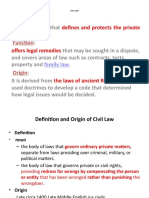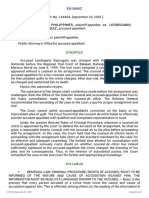100%(2)100% found this document useful (2 votes)
52 viewsDefinition of Civil Law (Glenn Maulana (Rubric 4) )
Definition of Civil Law (Glenn Maulana (Rubric 4) )
Uploaded by
glenn_maulanaCivil law defines and protects private citizen rights, covering areas like contracts, torts, and property. It originated from ancient Roman laws and codes used to resolve disputes. Civil law differs from criminal law in that its primary purpose is to resolve private disputes and provide compensation to injured parties, rather than punish undesirable acts. Civil cases involve private law and require a preponderance of evidence standard to reach a verdict, while criminal cases are tried by the government and require proof beyond a reasonable doubt.
Copyright:
© All Rights Reserved
Available Formats
Download as DOCX, PDF, TXT or read online from Scribd
Definition of Civil Law (Glenn Maulana (Rubric 4) )
Definition of Civil Law (Glenn Maulana (Rubric 4) )
Uploaded by
glenn_maulana100%(2)100% found this document useful (2 votes)
52 views2 pagesCivil law defines and protects private citizen rights, covering areas like contracts, torts, and property. It originated from ancient Roman laws and codes used to resolve disputes. Civil law differs from criminal law in that its primary purpose is to resolve private disputes and provide compensation to injured parties, rather than punish undesirable acts. Civil cases involve private law and require a preponderance of evidence standard to reach a verdict, while criminal cases are tried by the government and require proof beyond a reasonable doubt.
Original Title
Definition of Civil Law (Glenn Maulana (Rubric 4))
Copyright
© © All Rights Reserved
Available Formats
DOCX, PDF, TXT or read online from Scribd
Share this document
Did you find this document useful?
Is this content inappropriate?
Civil law defines and protects private citizen rights, covering areas like contracts, torts, and property. It originated from ancient Roman laws and codes used to resolve disputes. Civil law differs from criminal law in that its primary purpose is to resolve private disputes and provide compensation to injured parties, rather than punish undesirable acts. Civil cases involve private law and require a preponderance of evidence standard to reach a verdict, while criminal cases are tried by the government and require proof beyond a reasonable doubt.
Copyright:
© All Rights Reserved
Available Formats
Download as DOCX, PDF, TXT or read online from Scribd
Download as docx, pdf, or txt
100%(2)100% found this document useful (2 votes)
52 views2 pagesDefinition of Civil Law (Glenn Maulana (Rubric 4) )
Definition of Civil Law (Glenn Maulana (Rubric 4) )
Uploaded by
glenn_maulanaCivil law defines and protects private citizen rights, covering areas like contracts, torts, and property. It originated from ancient Roman laws and codes used to resolve disputes. Civil law differs from criminal law in that its primary purpose is to resolve private disputes and provide compensation to injured parties, rather than punish undesirable acts. Civil cases involve private law and require a preponderance of evidence standard to reach a verdict, while criminal cases are tried by the government and require proof beyond a reasonable doubt.
Copyright:
© All Rights Reserved
Available Formats
Download as DOCX, PDF, TXT or read online from Scribd
Download as docx, pdf, or txt
You are on page 1of 2
CIVIL LAW
Civil law is a body of rules that defines and
protects the private rights of citizens, offers
legal remedies that may be sought in a dispute,
and covers areas of law such as contracts, torts,
property and family law. Civil law is derived
from the laws of ancient Rome which used
doctrines to develop a code that determined
how legal issues would be decided. To explore
this concept, consider the following civil law
definition.
Civil Law vs. Criminal Law
Civil law and criminal law serve different
purposes in the United States legal system. The
primary purpose of civil law is to resolve
disputes and provide compensation for someone
injured by someone else’s acts or behavior. The primary purpose of criminal law is to
prevent undesirable behavior and punish those who commit an act deemed undesirable
by society.
In civil law, it is the injured person who brings the lawsuit. By contrast, in criminal law,
it is the government that files charges. The injured person may file a complaint, but it is
the government that decides whether criminal charges should be filed. A violation of
criminal law is considered a crime against the state or federal government and is a
violation of public law rather than private law.
Civil law cases are concerned only with private
law. In some instances, a person may be
entitled to file a complaint, trusting the legal
system to punish the wrongdoer with
prosecution, while bringing a civil lawsuit to
receive compensation for the damages done by
the wrongdoer.
Another key difference
between civil and Created By :
criminal law is the Glenn Maulana Adhiyaksa
standards of proof
required to reach a
verdict. A plaintiff need only prove his civil law
case by a “preponderance of evidence.” This
standard requires that the plaintiff convince the
court that, based on the evidence presented at trial, it is “more likely than not” that the
plaintiff’s allegation is true.
You might also like
- Civ Pro II OutlineDocument33 pagesCiv Pro II Outlinenoah4lmalt100% (1)
- Legal Language and Practical TrainingDocument110 pagesLegal Language and Practical Trainingalfiya100% (2)
- A Level LawDocument162 pagesA Level LawDr. Francesco Dergano100% (2)
- PNB Vs AndradaDocument3 pagesPNB Vs AndradaMigen SandicoNo ratings yet
- Rescissible Contracts: Arranged in The Order of Decreasing ValidityDocument10 pagesRescissible Contracts: Arranged in The Order of Decreasing ValidityJv Fermin100% (1)
- Session 1: Meaning - Object - Sources of Law - Civil Law vs. Criminal Law - Principle of Natural JusticeDocument34 pagesSession 1: Meaning - Object - Sources of Law - Civil Law vs. Criminal Law - Principle of Natural Justicepooja agarwalNo ratings yet
- Difference Between Criminal Law and Civil LawDocument13 pagesDifference Between Criminal Law and Civil LawSyed renobaNo ratings yet
- Civil Procedure Part I ashu Short NoteDocument55 pagesCivil Procedure Part I ashu Short Notehabtamuchalachew287No ratings yet
- Law Is Defined As A Rule of Conduct. These Rules of Conduct Are Just and Legislature) - They Are of Common Observance and BenefitDocument14 pagesLaw Is Defined As A Rule of Conduct. These Rules of Conduct Are Just and Legislature) - They Are of Common Observance and Benefitgary guzmanNo ratings yet
- Civil P.law Power Point Mettu UniversityDocument454 pagesCivil P.law Power Point Mettu UniversityTedy KassaNo ratings yet
- 1 Meaning & Need of LawDocument34 pages1 Meaning & Need of LawMaria U DavidNo ratings yet
- LM Important QuestionsDocument39 pagesLM Important QuestionsHarshNo ratings yet
- Civil LawDocument6 pagesCivil LawCC Ooi100% (1)
- ENGLEZA - Civil Law vs. Criminal Law - Definitions, Branches, ExamplesDocument13 pagesENGLEZA - Civil Law vs. Criminal Law - Definitions, Branches, ExamplesCristian VoicuNo ratings yet
- Commerical Law I SlidesDocument233 pagesCommerical Law I Slidessamuellacoffie7No ratings yet
- pyq-ans researchDocument5 pagespyq-ans researchFakir Sofikul Islam (Sofi)No ratings yet
- Important Concepts & Maxims - Some Notes On Lord DenningDocument10 pagesImportant Concepts & Maxims - Some Notes On Lord DenningJulius CaesarNo ratings yet
- Introduction To Business Law: Unit 1Document23 pagesIntroduction To Business Law: Unit 1gotham rNo ratings yet
- Session 6Document4 pagesSession 6Phạm LinhNo ratings yet
- LV 1st SubmissionDocument9 pagesLV 1st SubmissionMolika BansalNo ratings yet
- Session 1 The LawDocument17 pagesSession 1 The Lawqt5tfj69rrNo ratings yet
- Classification of LawDocument28 pagesClassification of LawRiya BoseNo ratings yet
- LEGAL METHOD LECTURE SERIES (THREE) 15th NOV 2022Document11 pagesLEGAL METHOD LECTURE SERIES (THREE) 15th NOV 2022De TrinahxNo ratings yet
- Law of Crimes Imp QuestionsDocument75 pagesLaw of Crimes Imp QuestionsSerNo ratings yet
- Meaning of Law: Introduction To Indian Legal SystemDocument6 pagesMeaning of Law: Introduction To Indian Legal SystemPradeep SinghNo ratings yet
- Andrea QwitterDocument11 pagesAndrea Qwitterandrewetyang142No ratings yet
- Obl IconDocument41 pagesObl IconHannah Joy BorjaNo ratings yet
- DYLAN ZIN Yr10 Commerce Yearly NotesDocument37 pagesDYLAN ZIN Yr10 Commerce Yearly Notesdylan.zinNo ratings yet
- Civil Law and Criminal LawDocument13 pagesCivil Law and Criminal Lawmariam100% (2)
- Introduction To Criminal LawDocument19 pagesIntroduction To Criminal LawGerald WopataNo ratings yet
- L 11 Classification of LawDocument12 pagesL 11 Classification of LawKartike JainNo ratings yet
- TORT LAW ASSIGNMENT 1Document5 pagesTORT LAW ASSIGNMENT 1elouisemgoodingNo ratings yet
- Criminal Law and Juvenile Justice LawDocument10 pagesCriminal Law and Juvenile Justice LawJordalyssa De VeraNo ratings yet
- Jurisprudence - HR 2017Document26 pagesJurisprudence - HR 2017Preetham ShanbhagNo ratings yet
- Introduction To Law Topic 1 - Part 2Document6 pagesIntroduction To Law Topic 1 - Part 2Phuong ThaoNo ratings yet
- Revise Penal Code by ReyesDocument236 pagesRevise Penal Code by ReyesJo-Ann Rose Roda Barenian100% (3)
- Intro To LEBDocument24 pagesIntro To LEBDebojyoti RoyNo ratings yet
- Malaysian Legal SystemDocument60 pagesMalaysian Legal SystemtedNo ratings yet
- Sem V - JurisprudenceDocument85 pagesSem V - Jurisprudencevarshabharathi1830No ratings yet
- Legal Aspect in Social Devlopment Work-1Document80 pagesLegal Aspect in Social Devlopment Work-1Chuxx MateiNo ratings yet
- Business LawDocument119 pagesBusiness Lawnancymasinde00No ratings yet
- 338 Introduction To Law Eng L10Document14 pages338 Introduction To Law Eng L10Sneha SolankiNo ratings yet
- Basic Concepts of LawDocument19 pagesBasic Concepts of Lawopith1949No ratings yet
- Business Law 1 NotesDocument74 pagesBusiness Law 1 NotesRANDAN SADIQ100% (4)
- Faculty of Law 2017/2018Document21 pagesFaculty of Law 2017/2018Juin KerkNo ratings yet
- 1) What Do You Understand by Law? Describe Function and Purpose of Law? What Is Law?Document34 pages1) What Do You Understand by Law? Describe Function and Purpose of Law? What Is Law?Harshada SinghNo ratings yet
- English 1Document3 pagesEnglish 1kim namjoonNo ratings yet
- Criminal Law I Finals Reviewer PDF PDFDocument287 pagesCriminal Law I Finals Reviewer PDF PDFRo CheNo ratings yet
- Criminal Law I Finals Reviewer PDFDocument287 pagesCriminal Law I Finals Reviewer PDFalfiedeckNo ratings yet
- Statute Civil Law: Judge Made LawsDocument2 pagesStatute Civil Law: Judge Made LawsJelminda AlfaroNo ratings yet
- Unit-2 (1) Probation Full ConceptDocument19 pagesUnit-2 (1) Probation Full Conceptbabykobase269No ratings yet
- Definition of LawDocument12 pagesDefinition of LawPutri Eka SariNo ratings yet
- Session 1 The LawDocument17 pagesSession 1 The Lawlannguyen220982No ratings yet
- Law of Torts Definition SDocument11 pagesLaw of Torts Definition SSachinNo ratings yet
- Torts and Damages ReviewerDocument6 pagesTorts and Damages ReviewerRen Concha100% (1)
- Chapter 1 (Obli)Document9 pagesChapter 1 (Obli)Rennejarek BenitezNo ratings yet
- What Is LawDocument2 pagesWhat Is LawXagonNo ratings yet
- 1.c. Law 2 Business Law Ppt. January 18 2nd SemDocument23 pages1.c. Law 2 Business Law Ppt. January 18 2nd SemNorhana IndolNo ratings yet
- Chapter 1Document11 pagesChapter 1Eric Bashi Femi MulengaNo ratings yet
- Chapter+1+Slides 2Document28 pagesChapter+1+Slides 2jharrar18No ratings yet
- Court Judges Terminology: Essential Terms for Criminal, Civil, Family, Administrative, and International LawFrom EverandCourt Judges Terminology: Essential Terms for Criminal, Civil, Family, Administrative, and International LawNo ratings yet
- Gilchrist V CuddyDocument3 pagesGilchrist V CuddyGabby GuecoNo ratings yet
- Respondent's Motion For Summary Judgment When A Contract of Guarantee Transformed To A Contract of SuretyDocument2 pagesRespondent's Motion For Summary Judgment When A Contract of Guarantee Transformed To A Contract of SuretyGeeAgayamPastor100% (1)
- Virata v. NG WeeDocument4 pagesVirata v. NG WeeNino Kim AyubanNo ratings yet
- 114694-2001-People v. Bascuguin y AcquizDocument7 pages114694-2001-People v. Bascuguin y AcquizNika RojasNo ratings yet
- Bill of ParticularsDocument10 pagesBill of Particularscmv mendozaNo ratings yet
- Katigbak v. SandiganbayanDocument1 pageKatigbak v. SandiganbayanjenizacallejaNo ratings yet
- Professional Negligence AvzxvccxvcxvDocument17 pagesProfessional Negligence Avzxvccxvcxvravi_mgd6No ratings yet
- Oblicon Reviewer Lecture Notes 1 10Document54 pagesOblicon Reviewer Lecture Notes 1 10Kim TriciaNo ratings yet
- PIL Reviewer CompleteDocument48 pagesPIL Reviewer Completeanon_659488182No ratings yet
- Tort FinallllllDocument20 pagesTort FinallllllRahul BarnwalNo ratings yet
- GNLU-NHRC 2019 Moot MemorialDocument47 pagesGNLU-NHRC 2019 Moot MemorialBhoomika G.S100% (4)
- G.R. No. 169891 November 2, 2006 Philippine National Railways, Petitioner, Ethel Brunty and Juan Manuel M. Garcia, RespondentsDocument10 pagesG.R. No. 169891 November 2, 2006 Philippine National Railways, Petitioner, Ethel Brunty and Juan Manuel M. Garcia, RespondentsRomNo ratings yet
- Dissolution of PartnershipDocument14 pagesDissolution of PartnershipChe_Ku_Mohamad_39740% (1)
- Andres Lao Vs CADocument1 pageAndres Lao Vs CAakaibengoshiNo ratings yet
- Torres Vs LapinidDocument5 pagesTorres Vs LapinidIsaias S. Pastrana Jr.No ratings yet
- Conflict of Laws AssignmentDocument9 pagesConflict of Laws AssignmentSamuel L ENo ratings yet
- Partcor ReviewerDocument26 pagesPartcor ReviewerMaui Mapue100% (2)
- Mistake of LawDocument2 pagesMistake of Lawxiguaplbmn0608100% (1)
- Judy Anne L. Santos,, - People of The Philippines and Bureau of Internal RevenueDocument7 pagesJudy Anne L. Santos,, - People of The Philippines and Bureau of Internal RevenueJude FanilaNo ratings yet
- PFR - Notes - Civil PersonalityDocument2 pagesPFR - Notes - Civil PersonalityKhay GonzalesNo ratings yet
- Memorial - PetitionerDocument25 pagesMemorial - PetitionerdivvyaapNo ratings yet
- Phielding Bundy v. Best Products Company, Inc., A Virginia Corporation, 843 F.2d 1386, 4th Cir. (1988)Document5 pagesPhielding Bundy v. Best Products Company, Inc., A Virginia Corporation, 843 F.2d 1386, 4th Cir. (1988)Scribd Government DocsNo ratings yet
- Aerospace Chemical v. CADocument13 pagesAerospace Chemical v. CAMichaelCalzado100% (1)
- Miami Rental Search LLC - Sunbiz 2021Document2 pagesMiami Rental Search LLC - Sunbiz 2021Omar Rodriguez OrtizNo ratings yet
- G.R. Nos. 116476-84 - Rosewood Processing, Inc. v. National Labor Relations CommissionDocument17 pagesG.R. Nos. 116476-84 - Rosewood Processing, Inc. v. National Labor Relations CommissionElla CanuelNo ratings yet
- Case Digest - Legal FormsDocument49 pagesCase Digest - Legal FormsShella VamNo ratings yet
- En Banc: Court of Tax AppealsDocument30 pagesEn Banc: Court of Tax Appealsmcguinto1No ratings yet

























































































